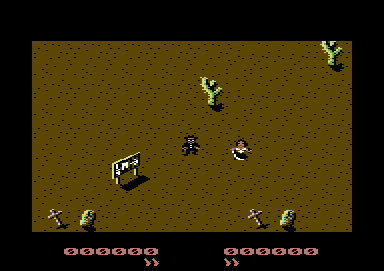
THE SEUCK VAULT
Main | Menus | Archive | Tips | Links | Contact
THE SECRET OF SEUCKCESS - PART TWO
By Jon Wells
This article first appeared in Commodore Format issue 31.
That first, inspired idea is one of the hardest - and most important - parts of any game's development. If it's to capture the imagination of players then it must be as original as possible. Your game may be a shoot-'em-up - after all you're using the Shoot-'Em-Up Construction Kit (SEUCK) - but that doesn't mean you have to limit yourself to space, guns and laser death.
Why not write a game where you're climbing up a building which is on fire? The plot would be to rescue people from the windows, your 'weapon' being a water cannon that douses fires as well as blasts enemies.
If you're doing a two-player game, why not introduce a female character to complement the male? (Oi, this sounds very sexist - Clur, aka Clare Hodgson.) The game Outlaw (see FIGURE 1), which is included with SEUCK, is an excellent example of this. Remember shoot-'em-up is a title that should describe your game and not limit it.

When you're using the Sprite Editor in SEUCK your sprites can be drawn in three colours: two multi-colours and one changeable sprite colour. For the changeable sprite colour you can use any one of the 16 colours that the C64 has to offer.
It's important to remember the restrictions of working with multi-colours. In this mode the C64 will only use two multi-colours for ALL of the sprites. What this means is that the two multi-colours have to stay the same for each and every sprite. (This also applies to BACKGROUND character graphics). So for maximum choice and effect, ensure that the multi-colours you choose contrast: so that, for example, one is dark while the other is light.
Always draw your sprites with a dark surrounding, as this makes the sprite look less blocky. As an experiment select dark green as your changeable colour and draw a solid circle to represent a sprite. (See FIGURE 2). At this stage the sprite will look blocky. Now draw a grey colour around the outside of the sprite. (See FIGURE 3). Notice the difference? Now, try drawing a small circle of light grey or white in the top left-hand corner to simulate light. (See FIGURE 4).
As a general rule, try to keep your sprites simple and don't be tempted to use high levels of colour and shading. Too much detail always makes them look messy.
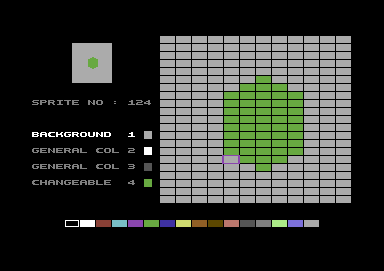
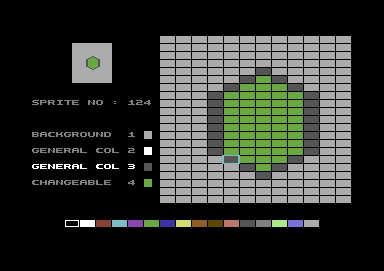
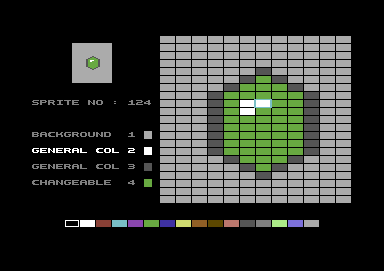
The Object Editor is used to make all the "characters" in your game. Not every character has to be out for your blood or form part of an attack wave. You can use the Object Editor to make either pick-ups or background animations (torches, smoke from houses, etc).
Using the Object Editor, it's possible to simulate sideways scrolling. To do this you can treat background objects as if they were enemy bullets. For example by turning a tree into an enemy bullet we can make it scroll across the landscape. First create a tree. Then create "Enemy One" as a filled-in sprite. Select the "fire type" as left, and then for the Bullet Object select the tree. Set the Bullet Speed to one and copy the Enemy Object to "Enemy Two". Now change the Bullet Speed for "Enemy Two" to two.
Enter the Attack Wave editor and store Enemy One at the far right of the screen. Now do the same for Enemy Two and place it just below Enemy One. Blank the enemy sprite graphics so you can't see them onscreen, and run the game with your level on STILL.
The tree bullets will move from right to left at different speeds, simulating a sideways-scrolling effect. (You may have to alter the fire rate at which the bullets appear to get the effect spot on.) This method was used in the Power Pack game Monster Mash for the jumping fish (See FIGURE 5) and was first invented by Alf Yngve, so he should get all the credit.
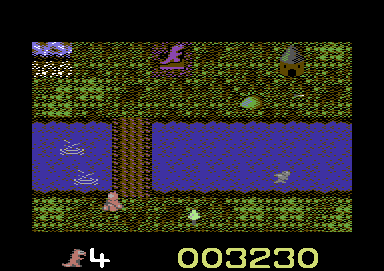
These should be designed with great care, as there is an option in the Player Limitation Screen to either kill or stop your sprite on contact with various backgrounds. So sloppy background design can make your game unplayable.
The first colour checked by the C64 when drawing a screen is the background colour (the dark blue that you first see when you restart your machine is the default background colour) and this is considered to be the first colour in the palette. Next in line are the two multi-colour shades, and like the sprites they must stay the same throughout the entire game.
The "changeable" colour is stored fourth, but for backgrounds it can only be selected from the first eight colours of the palette, and not all 16. This is because of the way multicolour graphics are drawn, as all 16 are only available in high-resolution (single colour) mode. SEUCK is designed to only use the multicolour mode.
It's wise to choose your two multi-colours from the "other" eight colours in the palette. For example, it would be a waste to choose white as the "light" multi-colour because you can select white as a changeable colour anyway. You'd be better off with light grey or green instead.
There's a specific trick that works with the black backgrounds commonly used for space games. Select the changeable colour as black throughout the game. This allows you to use the background as a "real" colour, and it can be any of the 16 in the palette. This does mean, though, that you'll be limited to the same three colours throughout the game!
The accompanying blasts, blips and bleeps of a SEUCK game are easily made with "The Kit" - once you know what the abbreviations mean and what functions they describe. (See FIGURE 6, below).
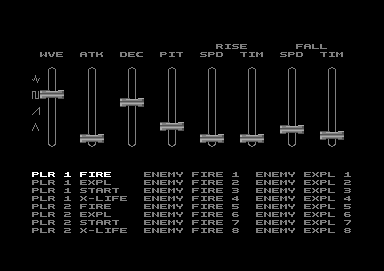
- WVE - the type of waveform you are using, these are from top down: RANDOM NOISE for explosion effects,
PULSE and SAWTOOTH for siren effects, TRIANGLE for whistle and flute effects.
- ATK - determines how fast the effect rises to its peak, and DEC(AY) determines how fast
the effect falls from this peak.
- PIT - determines the frequency, i.e. how low or high the note sounds, of the effect
- RISE - is the effect where a sound starts at a selected PITCH and then rises until it reaches a high point.
Then it returns to the starting pitch and repeats the cycle. This is reversed for the FALL option.
- SPD - these two determine the SPEED at which the RISE or FALL option happens.
- TIM - determines how long the effect runs before moving to the opposite effect, such as jumping from RISE
to FALL and back again.
It's easier to get your head around with an example, so here goes. To simulate a police siren you'd select the PULSE waveform, then move the ATTACK and DECAY sliders to the top. The PITCH should be in the middle and both SPEEDS must be set to slow (about 1cm from the bottom). Move both TIME settings to an equal point on the scale. The combination of these settings should create a wailing sound that rises and falls like a siren.
When planning how to kill your player it's worth remembering that if you position too many enemy sprites onscreen at one time, this will cause sprite flicker. This happens because the VIC chip can only position a maximum of eight different sprites onscreen at once. "So how come I've seen SEUCK games with 32 sprites onscreen at once then?" I hear you cry.
Normally you can only have eight sprites at once, but by using the IRQ Raster Interrupt the actual limitation is for eight sprites on any horizontal raster line. This type of routine is called a multiplexor and SEUCK has one built in.
SEUCK's multiplexor can handle about 32 sprites onscreen (four lots of eight). If there are nine sprites or more on any horizontal raster line then flicker will occur. Try to space your enemies out more and avoid too many enemies crossing each other's paths horizontally. Remember that the bullets are sprites too.
In a highly eco-friendly fashion, each level can actually be used more than once. Parts of them could be recycled to form another, later level. Imagine you had six levels and wanted to make another four. You could use parts of the first six levels to construct these other four instead of using up yet more map memory. The important thing to bear in mind is that the attack waves will be repeated as well as the map area.
The intro screen should be the last part of your game to be developed. It's here that you credit friends, relatives (the director, the producer, thanks luvvies... - Oscar). It's handy to note that your 'credits' may not use all the character set. This means there may be a little room in the character set for a picture to represent the game. For example you only need three numbers for the date (2,0 and 5) leaving seven other numbers for your modification. Using these and any spare letter characters you should be more than able to create a picture that can brighten up your title screen. (FIGURE 7 below shows an enhanced title screen from the game TWIN TIGERS, not possible in SEUCK without extra machine code).
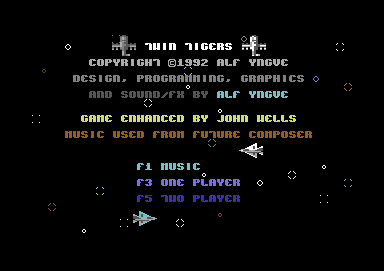
I say, I say, I say. When is a shoot-'em-up not a shoot-'em-up? When you've fiddled with the player limitations! (Erm, is that a joke, I don't understand - Ed.)
You can turn your blaster into a slasher just by tweaking the Bullet Duration. With this feature you can make your player 'appear' to use a short-range weapon - e.g. a sword, whip, dagger, club or fire (as in Monster Mash), rather than the traditional 'long-range' gun (see FIGURE 8). The lower the number of the Bullet Duration, the shorter distance your weapon (the bullet) will travel.
As an experiment, create a male/female sprite and then create a 'sword' sprite that will be the Player's Bullet Object. Set the Bullet Speed to two and the Duration to about seven in Player Limitations. Then, when you play the game, your player will appear to be swiping with the sword instead of shooting it. You may have to alter the speed or duration to get the best effect but the principle remains the same.
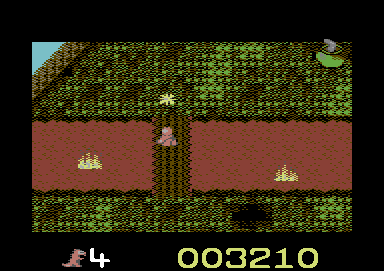
- Work out what's so good about your favourite games and try to include these elements in yours -
but don't resort to copying, 'Cos that's just too sad.
- Ensure that at least one new enemy appears on every level.
If all the enemies are on the first level there's little incentive to play on.
- Make each level look different or players will soon lose interest.
- Make backgrounds as colourful as possible. This may mean purple trees and blue cliffs, which
theoretically should look silly, but they often look rather neat.
- Design your graphics on paper first.
- Shoot-'Em-Up Construction Kit was released on budget by GBH
- Monster Mash is an enhanced SEUCK game by Jon Wells, released on Commodore Format Power Pack 31
- Twin Tigers by Alf Yngve and enhanced by Jon Wells, was released on Power Pack 25